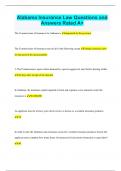Summary
HMPYC 80 - Research Methodology Summary Notes - Chapter 11
- Course
- Institution
- Book
Excellent quality study notes for the Honours module, HMPYC 80. This document contains study notes for Chapter 11 in Research at Grass Roots (5th edition). Perfect for tests, assignments and/or exams. The notes are in English and were summarised in 2021 using the textbook and the 2021 tutorial lett...
[Show more]





